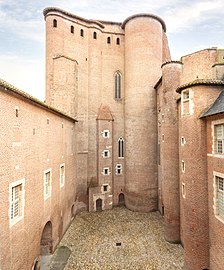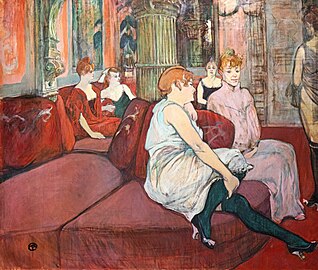Musée Toulouse-Lautrec
- View a machine-translated version of the French article.
- Machine translation, like DeepL or Google Translate, is a useful starting point for translations, but translators must revise errors as necessary and confirm that the translation is accurate, rather than simply copy-pasting machine-translated text into the English Wikipedia.
- Consider adding a topic to this template: there are already 6,211 articles in the main category, and specifying
|topic=will aid in categorization. - Do not translate text that appears unreliable or low-quality. If possible, verify the text with references provided in the foreign-language article.
- You must provide copyright attribution in the edit summary accompanying your translation by providing an interlanguage link to the source of your translation. A model attribution edit summary is
Content in this edit is translated from the existing French Wikipedia article at [[:fr:Musée Toulouse-Lautrec]]; see its history for attribution. - You may also add the template
{{Translated|fr|Musée Toulouse-Lautrec}}to the talk page. - For more guidance, see Wikipedia:Translation.
The Musée Toulouse-Lautrec is an art museum in Albi, southern France, dedicated mainly to the work of the painter Henri de Toulouse-Lautrec who was born in Albi. The 13th-century building was originally the Bishop's Palace of Albi Cathedral, next to it. It is part of the UNESCO World Heritage Site that includes the cathedral. [1]
The Bishop's Palace
The Bishop's Palace, or Palais épiscopal de la Berbi, was originally the residence of the bishop of Albi Cathedral, located next to the museum. It is included in the same UNESCO historical site as the cathedral. The Bishop's palace was begun before the Cathedral itself, by Bishop Durand de Beaucaire (bishop from 1228–1254). It was built with the features of a fortress during the period when the Catholic Church was at war with the a heretical sect called the Cathars, which originated in Albi.
Bishop de Combret, the next resident, further fortified his palace by connecting it to the Cathedral tower, twenty-five meters away. He added bastions and a machicoulis over the entrance, to drop heavy objects or boiling water on any attackers. The next owner, Bishop De Castanet, built a new wall around it and added Saint Catherine tower, which he linked to one of the towers of the cathedral.[2]
Later Bishops modified the palace by adding a new residence, a chapel and a French-style garden. and filled the interior with mosaics and art. In 1905, when the Cathedral and its properties were officially nationalised, and the Palace was given to the city of Albi for use as a museum.
-
 Entrance of museum
Entrance of museum -
 Palais de la Berbie, home of the Toulouse-Lautrec museum
Palais de la Berbie, home of the Toulouse-Lautrec museum -
 Exterior of the Palais de la Berbie
Exterior of the Palais de la Berbie -
 The garden of the Palais de la Berbie
The garden of the Palais de la Berbie
The Toulouse-Lautrec Museum
In 1922 the museum received an important collection of works by Henri de Toulouse-Lautrec, donated by his mother. The collection includes his last painting, Examination at the School of Medicine, from 1901. [3] [4]
The museum houses over a thousand works by[4] and about[5] Toulouse-Lautrec. It is based on a donation by Toulouse-Lautrec's mother after his death in 1901.
-
 Salon in the Rue des Moulins by Toulouse-Lautrec (1894)
Salon in the Rue des Moulins by Toulouse-Lautrec (1894) -
 Examination at the Faculty of Medicine (1901), last painting by Toulouse-Lautrec
Examination at the Faculty of Medicine (1901), last painting by Toulouse-Lautrec
See also
References
- ^ "Musee Toulouse-Lautrec". TripAdvisor. Retrieved 2 August 2016.
- ^ Sire 2013, p. 27.
- ^ Sire 2013, p. 27-28.
- ^ a b "Musée Toulouse-Lautrec | Albi, France Attractions". Lonely Planet. Retrieved 2020-11-15.
- ^ "Toulouse-Lautrec et Tremolada, adjoint de Zidler au Moulin-Rouge, 1892". La collection Toulouse-Lautrec (in French). Musées Occitanie. Retrieved 28 May 2022.
Bibliography
- Sire, Marie-Anne (2013). Cathédrale Saint-Cécile d'Albi (in French). Centre des monuments nationaux, Éditions du patrimoine. ISBN 978-2-7577-0263-5.
External links
- Official website
- v
- t
- e
- Count Alphonse de Toulouse-Lautrec Driving His Mail-Coach (1881)
- Portrait of Suzanne Valadon (1885)
- La Blanchisseuse (1886)
- Portrait of Vincent van Gogh (1887) (1887)
- La Toilette (1889)
- The Hangover (Suzanne Valadon) (1889)
- At the Moulin Rouge, The Dance (1890)
- Le Lit (1892)
- The Englishman at the Moulin Rouge (1892)
- At the Moulin Rouge (1892–1895)
- The Tightrope Dancer (1899)
- Moulin Rouge: La Goulue (1891)
- Divan Japonais (1893–94)
- Musée Toulouse-Lautrec
- Aristide Bruant
- Cha-U-Kao
- Jane Avril
- Marcelle Lender
- Suzanne Valadon
- Moulin Rouge (1952 film)
- Lautrec (1998 film)
- Moulin Rouge! (2001 film)
- Moulin Rouge! (2018 musical)
43°55′45″N 2°08′35″E / 43.92917°N 2.14306°E / 43.92917; 2.14306
 | This article related to an art display, art museum or gallery in France is a stub. You can help Wikipedia by expanding it. |
- v
- t
- e
















